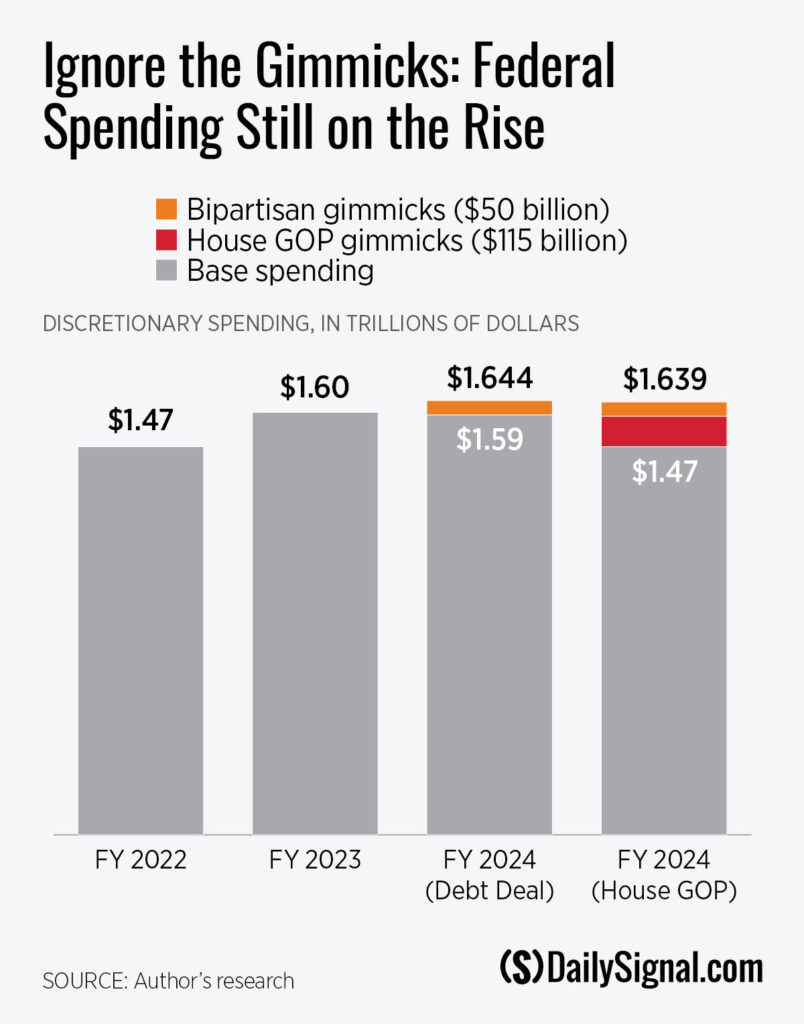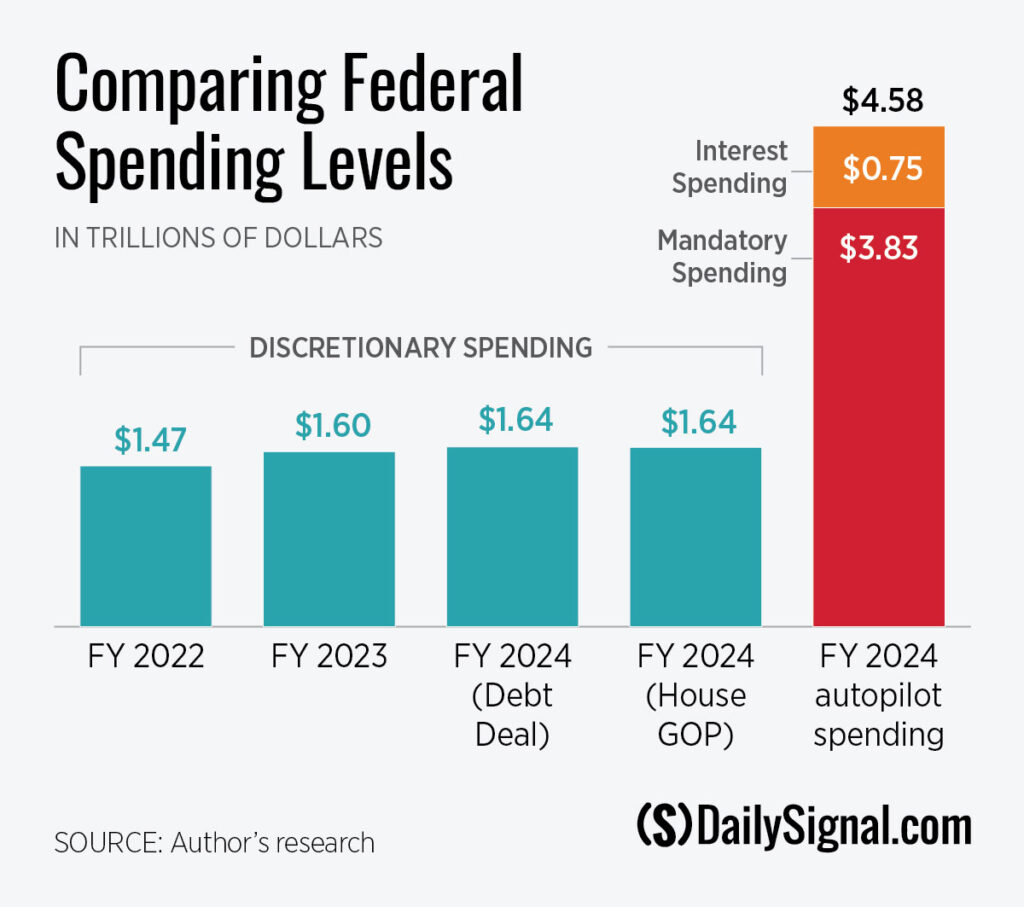American families must find ways to pinch pennies every day, especially in the face of massive inflation since the start of the Biden administration.
In contrast, the federal government has just reached the shameful milestone of $32 trillion in gross debt, or more than $245,000 for every household in the country. That’s the result of leaders in both parties ignoring responsible budgeting for decades.
Since Washington’s reckless deficit spending is one of the main causes of inflation, House conservatives are pushing for long-overdue spending cuts and a return to serious budgeting.
House Republicans passed the strong Limit, Save, Grow Act in April to create spending caps at fiscal year 2022 levels, eliminate left-wing waste, and rein in red tape.
Regrettably, most of that ended up on the cutting room floor as part of a bipartisan deal in May to raise the debt limit.
The deal included $54 billion in budget gimmicks for fiscal year 2024. That means using “rescissions” (cuts) in areas where little to no money would actually be spent, and the fake savings are used to boost programs where every last penny will go out the door.
The reason for this trickery is to pretend that 2024 spending would be the same as 2023, when in fact it would be higher after accounting for the gimmicks.
Some conservatives responded to the debt deal by holding up legislation on the House floor, demanding the lower spending levels that the GOP caucus sought earlier in the year. Republican leadership eventually agreed to this in exchange for resuming normal voting operations.
On June 12, the House Appropriations Committee announced that it would use the total spending level for fiscal year 2022 when producing spending bills for fiscal year 2024.
That should have been cause for celebration. Instead, the Washington establishment responded with predictable wailing and gnashing of teeth.
This reaction, along with details about how the House Appropriations Committee is reaching the lower spending level, reveals a lot about Washington’s dysfunctional environment.
- Only in Washington are fake spending-cut gimmicks a non-scandal.
Though the House Appropriations Committee is claiming to have marked up appropriations bills at fiscal year 2022 levels, that claim ignores the use of gimmicks.
In addition to the claimed spending levels, rescissions are being used to “offset” spending increases that get those bills back to the spending levels outlined by the debt limit deal—far above the 2022 level promise.
Since many of those cuts are to wasteful provisions passed by Democrats in 2021 and 2022, this is a modest improvement relative to the bipartisan debt deal.

However, as this chart shows, the functional spending level after including the gimmicks will be unchanged. If the point is to cut spending, the first step is to actually cut spending.
Since the gimmicks will be used to largely maintain spending levels for existing programs, that also means not properly dealing with the astonishing number of programs that use tax dollars from hardworking Americans to pay for political pork and the infrastructure of the Left.
The use and abuse of budget gimmicks on such a massive scale ought to be a headline-grabbing political scandal. However, since the mainstream media overwhelmingly supports the big government status quo, those details are buried.
- Only in Washington isn’t increasing spending a ‘cut.’
The language used by the press and Democrats about the new House spending limit is uniform: There will be “steep” spending cuts.
As the first chart shows, there won’t be substantial cuts due to the heavy use of budget gimmicks, yet Democrats claim this will “defund America.”
Just keeping spending flat is considered a “cut” because it goes against an assumption that there will be discretionary spending growth every year, as referenced above. The Washington establishment feels entitled to controlling ever-larger amounts of what Americans produce.
Apocalyptic rhetoric from Democrats is even more laughable when we consider that all the drama is over just a tiny fraction of total federal spending.

As this chart shows, while discretionary spending is big, it pales in comparison with “mandatory” spending, which includes Social Security, Medicare, and many other benefit programs. These programs are based on formulas and are projected to grow dramatically faster than the economy for decades to come.
Complaints about the federal government not spending enough shouldn’t be taken seriously.
- Only in Washington are deficit spenders ‘moderate’ and deficit fighters ‘extreme.’
House Minority Leader Hakeem Jeffries, D-N.Y., referred to House conservatives as “irresponsible individuals” in the spending fight. The media regularly use terms such as “agitator” and “hard-line” to describe conservatives who try to slow down Washington’s endless gravy train.
In contrast, members from both parties who are reliable votes for bloated spending packages—such as Sens. Susan Collins, R-Maine, and Joe Manchin, D-W.Va.—are regularly described as “moderate” in supposedly neutral press articles.
Recklessly adding to the national debt isn’t considered extreme, but pushing for modest spending cuts is somehow beyond the pale.
This is because, above all else, the Washington political and media establishments love the status quo of a powerful, big-spending federal government. Wasting untold billions on slush funds for pork and overpaid government employees is considered normal because it’s been going on for so long.
The few members who try to disrupt the corrupt use of public resources stand out as a threat.
- Only in Washington is a debt limit fight followed by legislation to increase deficits.
The political battle over how to address the federal debt limit lasted for weeks. As soon as it ended, committees got to work on increasing spending and adding even more to the national debt.
Most notable is the upcoming farm bill, which includes a mixture of corporate welfare for agribusiness and food stamps.
America’s very productive agricultural sector has benefited from high commodity prices, resulting in solid profits and a strong financial position across the industry.
Despite that, key legislators responsible for the farm bill have vowed to increase government price guarantees. That would lead to more subsidies, most of which are captured by the biggest and most financially sophisticated farming operations.
Another important piece of legislation this year is reauthorization of the Federal Aviation Administration. One of the FAA’s largest programs funds airport infrastructure, and the committees responsible for the bill are planning to increase those airport subsidies.
That would be the wrong approach in normal times, since there is a need for serious reforms to reduce federal control over the aviation sector and allow airports to pay for their own improvements. Increasing spending in the face of mountainous federal deficits is that much worse.
Unfortunately, it’s clear at this point that Washington isn’t going to start behaving responsibly on its own. The only way to stop the country from going bankrupt is for the American people to speak with one voice and demand serious change.
If politicians face serious consequences and accountability for abusing their power, they will have an incentive to do the right thing.
Editor’s note: A reference in this article to a House committee was initially incorrect. It has since been corrected.
Have an opinion about this article? To sound off, please email letters@DailySignal.com and we’ll consider publishing your edited remarks in our regular “We Hear You” feature. Remember to include the url or headline of the article plus your name and town and/or state.

























